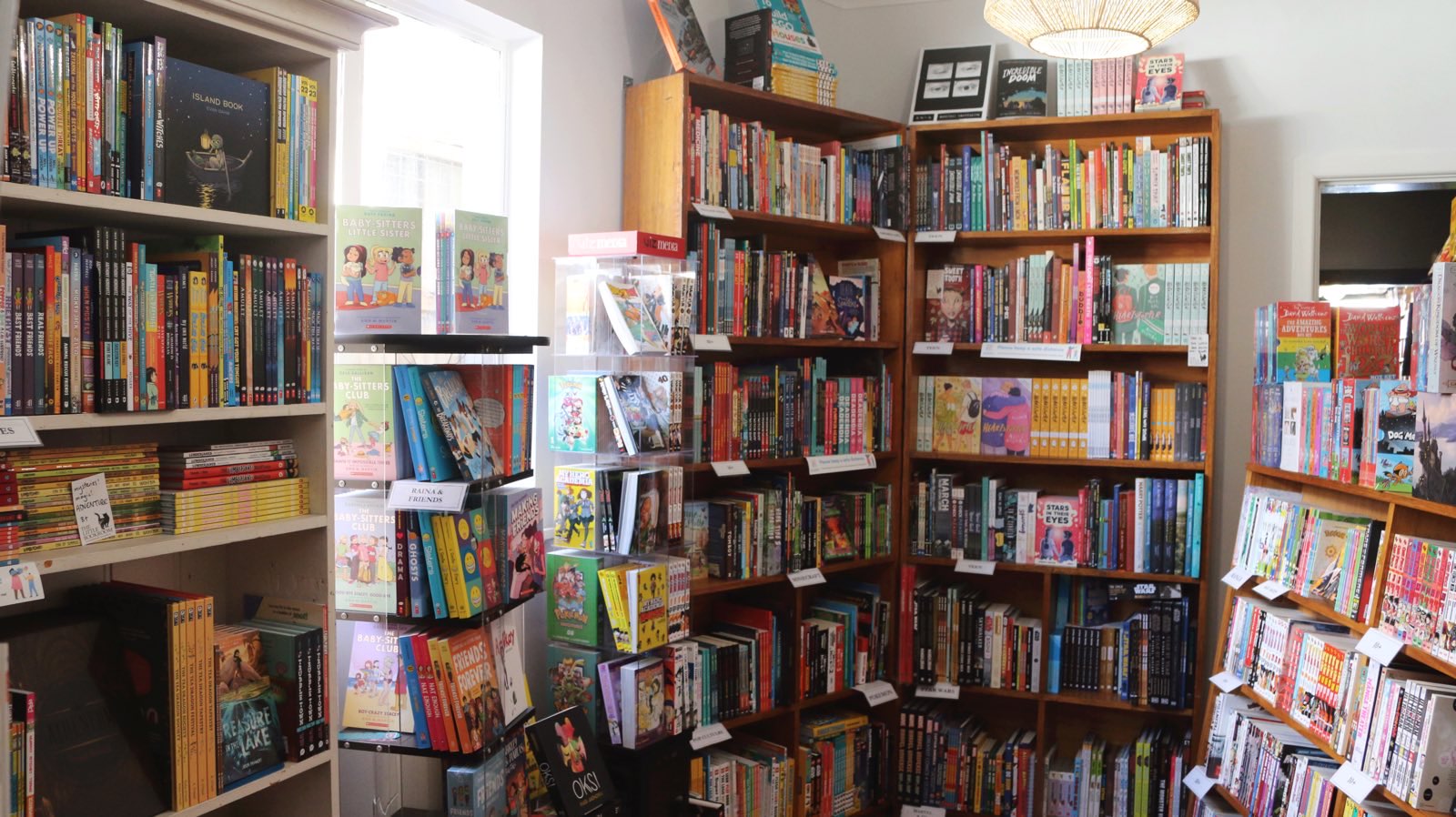Issue 121
Term 2 2022
Graphic novels and manga selection: 101
Michael Earp from The Little Bookroom has some quick tips to help you select great graphic novels and manga for your school library.
Graphic novels and manga have been areas of exponential growth for us at The Little Bookroom. We may be the world’s oldest children’s bookshop, but that doesn’t mean we can’t move with the times!
Before the pandemic hit, we had a small collection of our favourite hand-picked graphic novels as well as the harbingers of change, like Raina Telgemeier’s graphic novels. We now carry an extensive range that occupies two-thirds of the room they live in.

A picture of the graphic novels and manga section at The Little Bookroom.
At the time of writing, we have just shy of 1,100 individual titles in stock. Over the last year, sales have grown a further 30%. It is not (only) for my own pleasure that I order almost every graphic novel that crosses my path. We added graphic novels to our subscription services in January this year. It received the fastest response of all our subscription offers. Our readers want more. They are responding to having more choice.
I’ve always been excited by what the graphic novel format can offer. The pleasure of reading a picture book through the early (or late) years of life cannot be denied. So why would our desire for art with narratives fade just because we want a longer story? I will not accept that because these books have fewer words, they are somehow less valuable. The visual literacy skills they aid are bountiful. The gaps and mismatches between what’s said and what’s shown is a deep mine of meaning.
But we all agree we need them in our collections, which is why you’re reading this!
I’m still learning what to stock in the shop. It’s through conversations with customers, book clubbers and those engaged that I’m learning which are the hot series.
So, how to choose what to purchase for your library’s collection?
For starters, you don’t need to re-invent the wheel! You can rely on the same bestseller charts, reviews and bookseller recommendations you do for general fiction. But don't forget to bring across your regular development ethos with the following considerations.
Is it by Australian creators or published by an Australian publishing house?
Our local literary ecosystem is something we want to continue to thrive and grow. Graphic novels are hard to financially justify because of their high production costs. We heartily get behind any Australian endeavour to prove that there is a market and encourage more.
Does it have engaging stories and characters that reflect
the diversity of society?
Readers are very keen to see themselves reflected in what they read. That might be in school dramas or sharing an identity trait while fighting aliens in space. I’m always asking myself, ‘Who’s missing?’ Luckily, the answer to that question will lead you to what to buy next.
Is it appealing?
Talk about a subjective landmine! But the format, quality of publishing, and cover design helps lead to titles more likely to be borrowed.
Have you covered a range of emotional states?
It’s not all hilarious nonsense (like Dog Man) for the lower end. It’s not all heart-wrenching historical trauma (like Maus) for the older readers. Indeed, it might surprise some that it’s not even all about superhero comics. Licenced ranges of comics like DC and Marvel are a tiny portion of our store’s sales. (Although I’ll confess, they are an enormous global market.) Ensuring you have as much levity for teens as you do identity drama for primary can balance the scales.
‘But what about manga?’ you ask, with a troubled look on your face. ‘I don’t know where to start!’ Don’t worry, we’ve all been there. My first job as a bookseller was in Sydney’s Kinokuniya. I’m well aware entire bookstores could be filled with manga and barely make a dent in what’s available. Do you know what gives me reassurance? Just because it exists, doesn’t mean you need it all. I’m shown 1,000 to 2,000 new release titles every month. (And that’s just for 0–18-year-olds!) I do not order them all, or even consider ordering them all.
Just because something is less familiar to you, should not make it a daunting task that you ignore altogether. Manga is relatively new to me, too. But as much of a novice as I am, do you know who’s an expert? Your readers. I’m still learning what to stock in the shop. It’s through conversations with customers, book clubbers and those engaged that I’m learning which are the hot series. There is trial and error, as with your regular collection development.
I’ll use Viz Media (a publisher) as an example to help vet the recommendations you might get from kids. Kids are always eager to push the limits of what they’re permitted to read. Viz Media has a rating system that is printed on the back of all their manga. A = All Ages, T = Teen, T+ = Teen Plus, M = Mature. The way I have interpreted these ratings in a practicable manner is: A = Fair game. T = Sometimes quite violent, but often read by kids aged 10+ without much concern from them or their parents. Suitable for upper primary and all of high school. T+ = Just as violent, if not more so than T, but also with sexual content being introduced. I’d limit these to high-school-aged readers. M = Probably not ones to stock in a library for those under 18. Older readers might access them in other ways, but I don’t need to be the one to put it in their hands.
All in all, yes, there’s a lot to consider when buying visual texts for your library. Keep going. There is so much delight and depth to be discovered. I wrote about the way we categorise our graphic novels in my Schools and libraries newsletter late last year. I got a lot of feedback that it was extremely helpful. It showed teachers, parents and even publishers how to approach the incredible, growing, amorphous mass that is graphic novels and manga. I’ll finish with a short list of brilliant Australian graphic novels from the past 18 months that we, and our readers, have loved.
- Ollie and Bea by Renee Treml (Year P–3)
- Pawcasso by Remy Lai (CBCA Notable 2022; Year 3–8)
- Stars in their eyes by Jessica Walton and Aśka (CBCA Notable 2022; Year 5–12)
- Underground by Mirranda Burton (CBCA Notable 2022; Year 9–12)
- Still alive by Safdar Ahmed (CBCA Notable 2022; Year 9–12)
